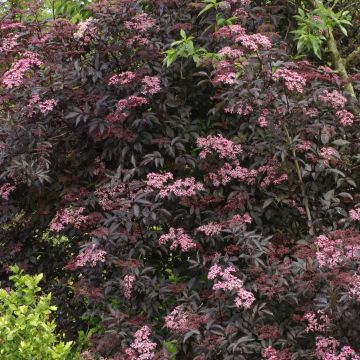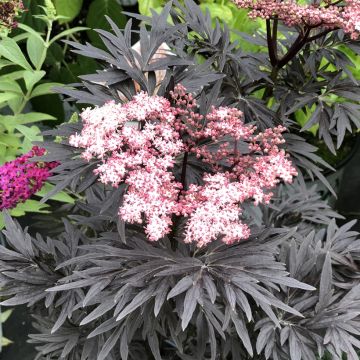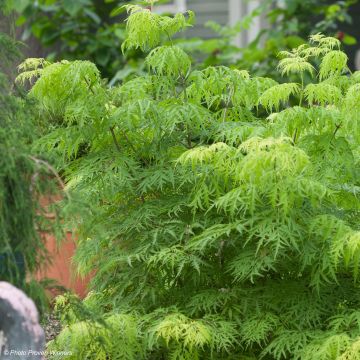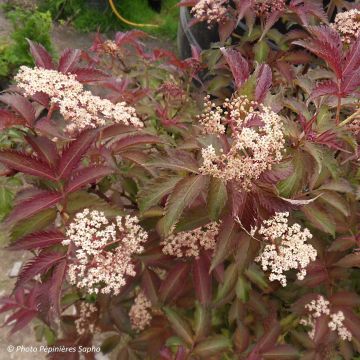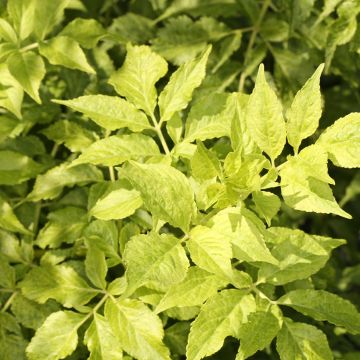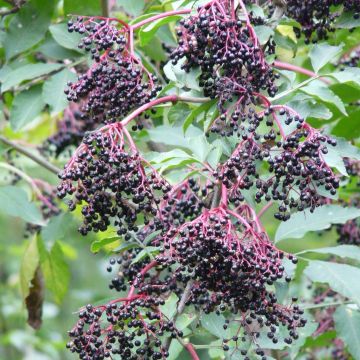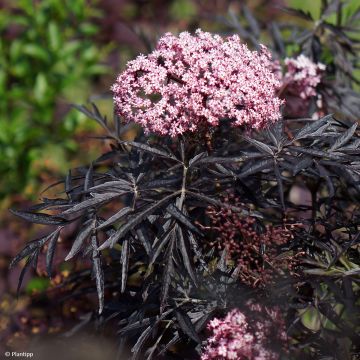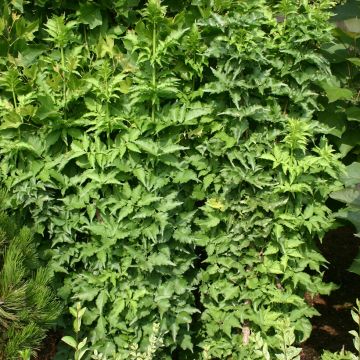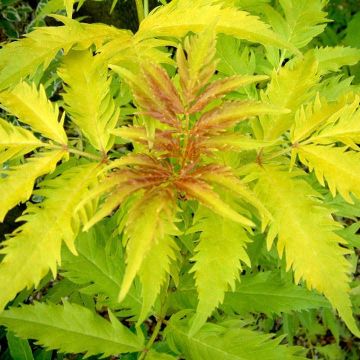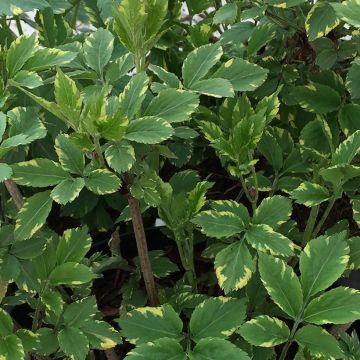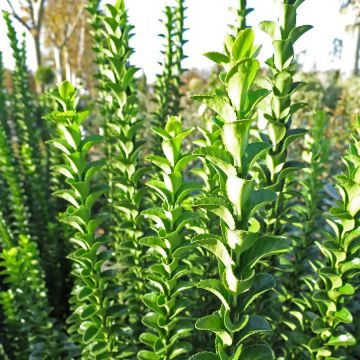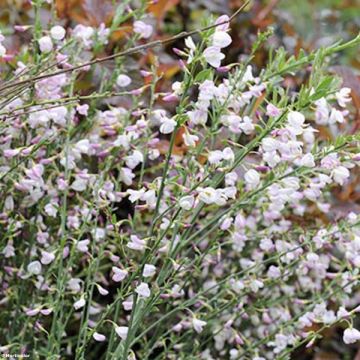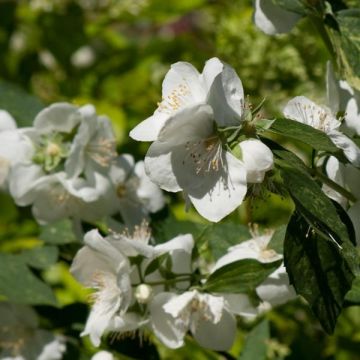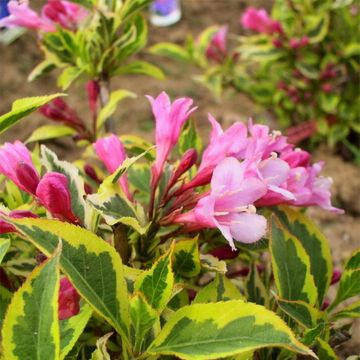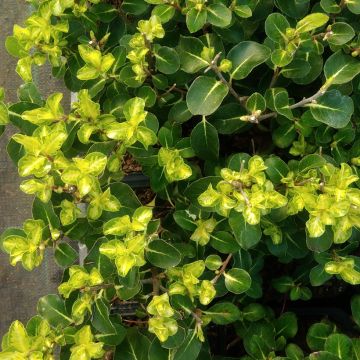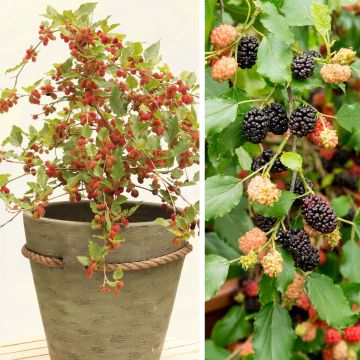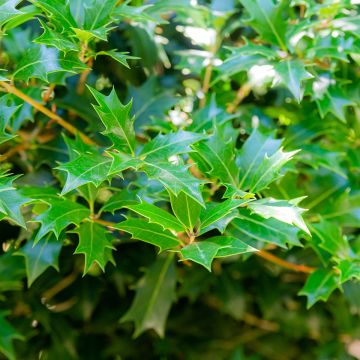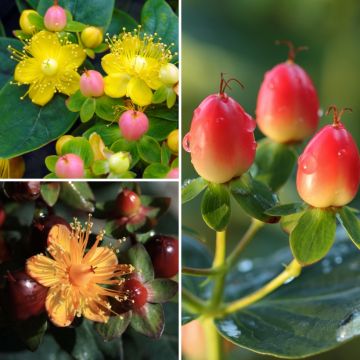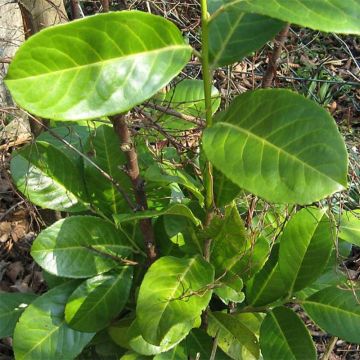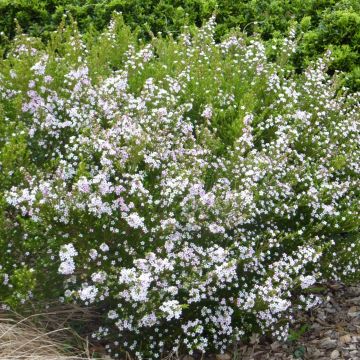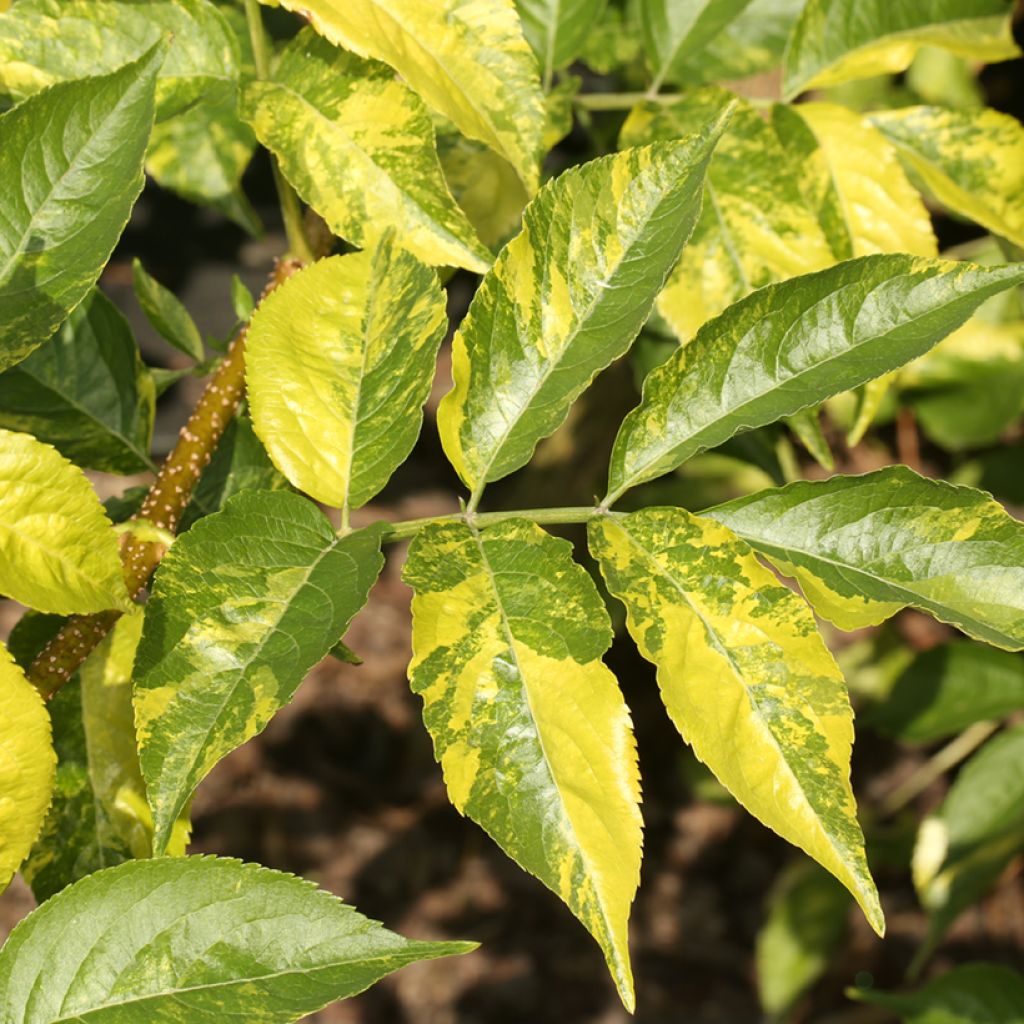

Sambucus nigra Anatole - Elder
Sambucus nigra Anatole - Elder
Sambucus nigra Anatole
Elder, Black Elder, European Elder, Elderberry
This item cannot be shipped to the selected country
Delivery charge from €5.90
Delivery to Corse prohibited
More information
Schedule delivery date,
and select date in basket
This plant carries a 24 months recovery warranty
More information
We guarantee the quality of our plants for a full growing cycle, and will replace at our expense any plant that fails to recover under normal climatic and planting conditions.
From €5.90 for pickup delivery and €6.90 for home delivery
Express home delivery from €8.90.
Delivery to Corse prohibited: UE law prohibits the import of this plant from mainland France to Corse as part of the fight against Xylella fastidiosa. Please accept our sincere apologies.
More information
Does this plant fit my garden?
Set up your Plantfit profile →
Description
Sambucus nigra 'Anatole' is a beautiful form of the black elderberry with large, fresh green to golden foliage. The young leaves that appear in spring are lime green and as they mature, the irregular mosaic of two colours, dark green and yellow, becomes more pronounced. In early summer, it is adorned with large, fluffy white umbels, followed by edible black berries. This cultivar grows vigorously and forms a large, upright, wide and rounded bush. It blooms and fruits less than the species.
Sambucus nigra 'Anatole' is a plant belonging to the Caprifoliaceae family, just like honeysuckles. It is derived from Sambucus nigra, a wild species found in Europe, North Africa, and as far as Asia Minor. The black elderberry is an opportunistic and highly adaptable wild species, found in open woods, hedges, fallow land, coastal dunes, as well as near human settlements where it has coexisted for millennia. It is therefore an undemanding shrub that is easy to grow anywhere. The 'Anatole' form has an upright and rounded habit and reaches a height of 3 to 5 m with a width of 2 to 4 m, with fairly vigorous growth. Its foliage is particularly bright; its leaves are longer than those of the species, about 15 cm long. They are divided into many lemon-green leaflets in spring. In summer, the foliage alternates between dark green and light green. Flowering usually occurs in June (a little earlier or later depending on the climate), in the form of long-lasting false umbels, 10 to 20 cm wide. The small, fragrant white flowers, with 5 petals, are borne on reddish petioles. The edible and delicious fruits are black to purplish berries, with soft flesh, measuring 6 to 8 mm in diameter.
The 'Anatole' black elderberry is an excellent hedge shrub, to be protected from scorching sun that would damage its foliage. The light colour of the foliage makes the 'Anatole' elderberry perfect for colourful compositions or as a light background for smaller shrubs with dark green or purple foliage. You can also plant a row of elderberry varieties with different colours: from yellow to bicoloured and from dark green to dark burgundy. Like all elderberries, it is very hardy and easy to integrate into a spring or summer flowering shrub bed, such as lilacs, mock oranges, viburnums, or as a backdrop behind tall perennials (Gunnera, Ligularia, large ferns in moist soil) or along a pathway. You can also keep it in a large pot or container for many years.
In the kitchen: the flowers can be used to make fritters or syrup by macerating them in sugar. The flower buds can be used to enhance salads, and the berries can be consumed as juice, jellies or jams, or made into wine. They add a pleasant fragrance to apple cakes. Only the flowers and berries without their petioles are edible, the rest of the plant can be toxic.
In the garden:
Elderberry leaves are known to accelerate compost decomposition. Black elderberry leaf infusion is useful in organic gardening to fight against mildew and aphid attacks, or rodents: macerate 1 kg of leaves in 10 L of water for a few days and spray as needed. It can also be planted in an orchard, where it attracts insect-eating birds.
Report an error about the product description
Plant habit
Flowering
Foliage
Botanical data
Sambucus
nigra
Anatole
Caprifoliaceae
Elder, Black Elder, European Elder, Elderberry
Cultivar or hybrid
Other Sambucus - Elder tree
Planting and care
Easy to grow, the Anatole elderberry can be planted in spring or autumn, in any ordinary soil that is not too poor, deep enough, and not too dry, although it tolerates temporary periods of drought in deep soil once well established. It requires little maintenance. Plant it in a semi-shady location, as intense sunlight would scorch its beautiful foliage. It is not very demanding in terms of soil, tolerating clay, limestone, sand, and even degraded soils. The ideal planting mix is half compost/half garden soil. It is very hardy. To promote flowering, prune the old branches heavily and cut back the young branches by one-third in late winter.
Planting period
Intended location
Care
This item has not been reviewed yet - be the first to leave a review about it.
Hedge shrubs
Haven't found what you were looking for?
Hardiness is the lowest winter temperature a plant can endure without suffering serious damage or even dying. However, hardiness is affected by location (a sheltered area, such as a patio), protection (winter cover) and soil type (hardiness is improved by well-drained soil).

Photo Sharing Terms & Conditions
In order to encourage gardeners to interact and share their experiences, Promesse de fleurs offers various media enabling content to be uploaded onto its Site - in particular via the ‘Photo sharing’ module.
The User agrees to refrain from:
- Posting any content that is illegal, prejudicial, insulting, racist, inciteful to hatred, revisionist, contrary to public decency, that infringes on privacy or on the privacy rights of third parties, in particular the publicity rights of persons and goods, intellectual property rights, or the right to privacy.
- Submitting content on behalf of a third party;
- Impersonate the identity of a third party and/or publish any personal information about a third party;
In general, the User undertakes to refrain from any unethical behaviour.
All Content (in particular text, comments, files, images, photos, videos, creative works, etc.), which may be subject to property or intellectual property rights, image or other private rights, shall remain the property of the User, subject to the limited rights granted by the terms of the licence granted by Promesse de fleurs as stated below. Users are at liberty to publish or not to publish such Content on the Site, notably via the ‘Photo Sharing’ facility, and accept that this Content shall be made public and freely accessible, notably on the Internet.
Users further acknowledge, undertake to have ,and guarantee that they hold all necessary rights and permissions to publish such material on the Site, in particular with regard to the legislation in force pertaining to any privacy, property, intellectual property, image, or contractual rights, or rights of any other nature. By publishing such Content on the Site, Users acknowledge accepting full liability as publishers of the Content within the meaning of the law, and grant Promesse de fleurs, free of charge, an inclusive, worldwide licence for the said Content for the entire duration of its publication, including all reproduction, representation, up/downloading, displaying, performing, transmission, and storage rights.
Users also grant permission for their name to be linked to the Content and accept that this link may not always be made available.
By engaging in posting material, Users consent to their Content becoming automatically accessible on the Internet, in particular on other sites and/or blogs and/or web pages of the Promesse de fleurs site, including in particular social pages and the Promesse de fleurs catalogue.
Users may secure the removal of entrusted content free of charge by issuing a simple request via our contact form.
The flowering period indicated on our website applies to countries and regions located in USDA zone 8 (France, the United Kingdom, Ireland, the Netherlands, etc.)
It will vary according to where you live:
- In zones 9 to 10 (Italy, Spain, Greece, etc.), flowering will occur about 2 to 4 weeks earlier.
- In zones 6 to 7 (Germany, Poland, Slovenia, and lower mountainous regions), flowering will be delayed by 2 to 3 weeks.
- In zone 5 (Central Europe, Scandinavia), blooming will be delayed by 3 to 5 weeks.
In temperate climates, pruning of spring-flowering shrubs (forsythia, spireas, etc.) should be done just after flowering.
Pruning of summer-flowering shrubs (Indian Lilac, Perovskia, etc.) can be done in winter or spring.
In cold regions as well as with frost-sensitive plants, avoid pruning too early when severe frosts may still occur.
The planting period indicated on our website applies to countries and regions located in USDA zone 8 (France, United Kingdom, Ireland, Netherlands).
It will vary according to where you live:
- In Mediterranean zones (Marseille, Madrid, Milan, etc.), autumn and winter are the best planting periods.
- In continental zones (Strasbourg, Munich, Vienna, etc.), delay planting by 2 to 3 weeks in spring and bring it forward by 2 to 4 weeks in autumn.
- In mountainous regions (the Alps, Pyrenees, Carpathians, etc.), it is best to plant in late spring (May-June) or late summer (August-September).
The harvesting period indicated on our website applies to countries and regions in USDA zone 8 (France, England, Ireland, the Netherlands).
In colder areas (Scandinavia, Poland, Austria...) fruit and vegetable harvests are likely to be delayed by 3-4 weeks.
In warmer areas (Italy, Spain, Greece, etc.), harvesting will probably take place earlier, depending on weather conditions.
The sowing periods indicated on our website apply to countries and regions within USDA Zone 8 (France, UK, Ireland, Netherlands).
In colder areas (Scandinavia, Poland, Austria...), delay any outdoor sowing by 3-4 weeks, or sow under glass.
In warmer climes (Italy, Spain, Greece, etc.), bring outdoor sowing forward by a few weeks.

































